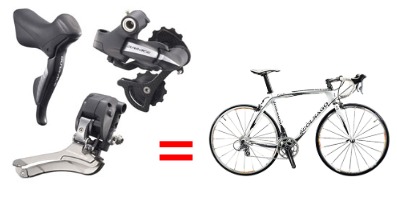
Shimano’s electronic road group Di2 (or “Electronic Dura Ace” as some are calling it) has been lauded by many as being one of the most significant developments in bike drivetrain development since the derailleur. Even many detractors who feel that the group simply complicates a mechanical arrangement that’s been slowly perfected for the better part of the century recognize the craftsmanship that goes into creating a new and complex mechanism like the self-centering auto-trimming motors that drive the system.
Luckily, Di2 has an incredibly affordable price with the suggested retail on the complete group only around $5500. Wait, is this right? That must be a typo. I’m going to just make a call and be right back.
Shimano Di2 is a roughly $2500 premium over the DA 7900 group that makes up the core of the package. That means that the additional scratch is dedicated solely to the shifters, the battery unit and the front and rear derailleur mechanisms.
So why such a high price? Everyone I know who was looking forward to trying out the new shifting has decided to drop the idea. And that, I think is the point.
The rationale for high pricing
The Shimano Di2 group likely has a higher level of Research and Development costs associated with it than anything else the company has ever produced. While other products in the Shimano family are incremental improvements from an engineering standpoint (even if the improvements have a major impact) the electronic guts of the new groupo is a whole different game. Precision control motors, circuit boards and battery technology is a world apart from their other products.
Granted then that there are much higher R&D costs associated with the group so you’d expect a higher price, but not perhaps one that’s more than twice the cost of the top-of-the-line group it’s based on. (Since the DA 7900 complete kit includes mechanical shifters and derailleurs, the cost of the group without those parts would be lower, the cost of the Di2 is that much higher.)
Assuming a price difference of $3000, it would take just 3333 groups sold to gross $10M, a hefty R&D amount (and a number I’m pulling out of the air to represent a huge R&D cost). Price the group at a $1500 margin and it would take around 6000 bikes to hit that same gross. Spread that out over the life span of something like a high-end bike group and that’s a pretty easy number to hit.
So why is the price tag so high? I think it’s to keep people from buying it. Why would Shimano want to keep people from buying their new group? A few reasons.
First, the Di2 group is clearly and largely a shot across the bow of Campy and SRAM, the two major players that battle for the high-end bike dollars of consumers. SRAM’s group came out of virtual thin air a few years ago and took a huge chunk of market share while Campy’s new 11-speed Record group competes for the finesse market–customers who are looking for the ultimate artistic statement with their bikes.
Meanwhile, Shimano just launched DA 7900, a very well reviewed upgrade to their Dura Ace line. With considerably less R&D to swallow in the 7900 group each package likely makes a nice bit of profit and with the raves the group has garnered adds to the prestige of the company in the face of ever-growing competition.
Di2 meanwhile is a virtual unknown in the market. It’s been on bikes in secret for a few years, but it’s never been for sale. A single misstep could spell the end of the product line and a huge loss of face for Shimano. With a mass-produced product that’s never been rolled out to many customers, it’s impossible to know if any of the parts might fail under use. That’s risky.
But Shimano realizes that the only way to really vet the group is to put it on bikes. Unlike other demo groups that can be tested at races with little attention, it’s impossible to conceive of Di2 rolling out at a major race without the press going nuts over it.
So here’s Shimano’s likely dilemma–they’ve got a technology that could conceivably set the standard for cycling in the century, featuring a heavy load of new and unproven (from a long-term standpoint) engineering that’s designed for the most picky and sophisticated customers the company has.
The solution is to price the components so stratospherically high that not only does each group help quickly recoup R&D but it ensures that the Di2 parts only end up on a handful of bikes–those belonging to some sponsored race teams and to high-end custom-bike buyers. If the group fails in low-yield deployment, just replace it out, swallow the cost and make the customer happy. Spend a few years getting feedback, update the product and then roll it out at a consumer-friendly price point.
If this seems farfetched, consider Mavic’s current dilemma (ignoring their electronic shifting debacle of the past). Less than a year after releasing a wheelset based around a new cylindrical carbon spoke the company was forced to issue a voluntary recall because of potential spoke failure. As a result of the wide-scale recall dealers are reporting that the company is having problems fulfilling orders for other products as well. It’s a bit of a PR nightmare for a company that was attempting to redefine a technology.
Personally I have no doubt that a few years from now either Di2 or a Di2 derived technology will be found on huge numbers of bikes and that we’ll look back at the release of the group with the same awe that we do the original Dura Ace. In the meantime though, only those with deep enough wallets will be able to ride today on a bit of tomorrow’s technology.
…We're riding townies, adventure, and mountain bikes. Find recommendations on our store page. As Amazon Associates we earn from qualifying purchases.